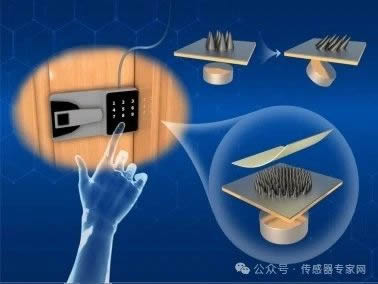Human beings perceive the world through their skin, and touch is the bridge that connects physics and cognition. Nowadays, a technology called "tactile sensors" is giving machines, devices, and even intelligent agents similar perceptual abilities. From industrial robots to medical surgical instruments, from wearable devices to future humanoid robots, tactile sensors are quietly reshaping the boundaries of human-computer interaction and automation revolution.

一、 Tactile Sensor: The "Sixth Sense" of Machines
Tactile sensors are a type of device that converts external physical stimuli (such as pressure, temperature, friction, vibration, etc.) into electrical signals. Their core function is to simulate the tactile perception of human skin. For example, when industrial robots grab fragile items, tactile sensors can provide real-time feedback on force to avoid damage; In the medical field, surgical robots perceive tissue hardness through tactile feedback to improve operational accuracy.
According to the working principle, tactile sensors can be divided into resistive, piezoelectric, capacitive, photoelectric, flexible electronic skin and other types. Among them, flexible electronic skin (also known as "electronic skin") is a technological breakthrough in recent years: it uses nanomaterials or flexible substrates, with similar flexibility and extensibility to human skin, and can even cover curved or irregular object surfaces, achieving high-precision and multi-dimensional tactile perception.
二、 Technological evolution: from "hard" to "soft", from "single" to "intelligent"
The technological iteration history of tactile sensors is an evolutionary history of pursuing anthropomorphism:
1. Miniaturization and Integration: MEMS (Micro Electro Mechanical Systems) technology reduces the size of sensors to the millimeter level, reducing costs while significantly improving sensitivity and response speed. For example, pressure touch screens in smartphones and pressure distribution monitoring in car seats rely on MEMS tactile sensors.
2. Flexibility Revolution: Traditional sensors are limited by rigid structures and difficult to adapt to complex surfaces. The flexible electronic skin achieves stretchable and bendable tactile perception through materials such as silver nanowires and graphene. For example, the flexible tactile skin developed by Tampere University in Finland has been applied to prosthetics, enabling amputees to perceive object texture and temperature.
3. Multimodal perception: In the future, tactile sensors will integrate multi-dimensional perception capabilities such as pressure, temperature, humidity, and material recognition. For example, the electronic skin developed by the Massachusetts Institute of Technology (MIT) for NASA astronaut robots can simultaneously sense pressure, temperature, and surface roughness of objects.
4. Intelligence and self-learning: Combining AI algorithms, tactile sensors can achieve a "perception decision feedback" closed loop. For example, in industrial quality inspection, sensors automatically identify product defects and even predict equipment wear through machine learning.
三、 Application scenarios: From laboratories to various industries
The application field of tactile sensors is moving from the laboratory to reality, becoming a core supporting technology in intelligent manufacturing, medical health, consumer electronics and other fields.
1. Industrial automation: In automotive manufacturing, tactile sensors can monitor welding strength in real time to avoid virtual welding; On the 3C electronic assembly line, robots accurately grasp small components through tactile feedback, increasing the yield rate to over 99%.
2. Medical health: Surgical robots achieve "force control operation" through tactile feedback, allowing doctors to perceive tissue resistance and reduce surgical risks; Intelligent prosthetics combined with tactile sensors enable amputees to perceive the hardness and shape of objects through their skin.
3. Consumer electronics: Wearable devices monitor heart rate, blood pressure, and even emotional fluctuations through flexible tactile sensors; VR/AR devices use tactile gloves to simulate the tactile sensation of virtual objects, enhancing immersion.
4. Humanoid robots: Tesla Optimus, Boston Dynamics Atlas and other robots are equipped with tactile sensors to achieve complex tasks such as object grasping and tool operation. In the future, tactile sensors will cover the entire body of robots, giving them perception abilities similar to those of humans.
5. Special environmental operations: In high-risk scenarios such as deep-sea exploration and nuclear radiation cleanup, tactile sensors can remotely sense environmental information to ensure personnel safety.
四、 Challenge and Future: Flexibility, High Precision, Low Cost
Despite its broad prospects, tactile sensors still face technological bottlenecks:
Materials and processes: The long-term stability and durability of flexible electronic skin still need to be improved; Large scale mass production requires breakthroughs in the preparation and packaging processes of nanomaterials.
Cost control: High precision sensors are expensive, which limits their popularity in the consumer market.
Standardization and compatibility: The sensor interfaces and data protocols of different manufacturers have not been unified, which restricts the efficiency of system integration.
In the future, tactile sensors will develop in the following directions:
1. Flexibility and biomimicry: Imitate the neural network structure of human skin to achieve self-healing and adaptive tactile perception.
2. Low power consumption and wireless technology: Combining flexible batteries with wireless communication technology to promote the popularization of wearable devices and smart fabrics.
3. Interdisciplinary integration: Deeply integrating biomedical, materials science, and AI technology to develop sensors that can perceive advanced tactile sensations such as pain and emotions.
五、 Conclusion: Perceive the future, within reach
From the intelligent factories of Industry 4.0, to the immersive interaction of the metaverse, and to the intelligent care of an aging society, tactile sensors are becoming the "nerve endings" that connect the physical world and the digital world. With breakthroughs in materials science, AI algorithms, and manufacturing processes, future tactile sensors will be more flexible, intelligent, and user-friendly, giving machines a truly accessible future.
Perhaps in the near future, when you shake hands with a robot, you will be able to feel the temperature and strength in its palm; When you wear smart gloves to operate virtual tools, the touch of your fingertips will be no different from reality. All of this began with the silent 'perception revolution' of tactile sensors.
Source: Sensor Expert Network



